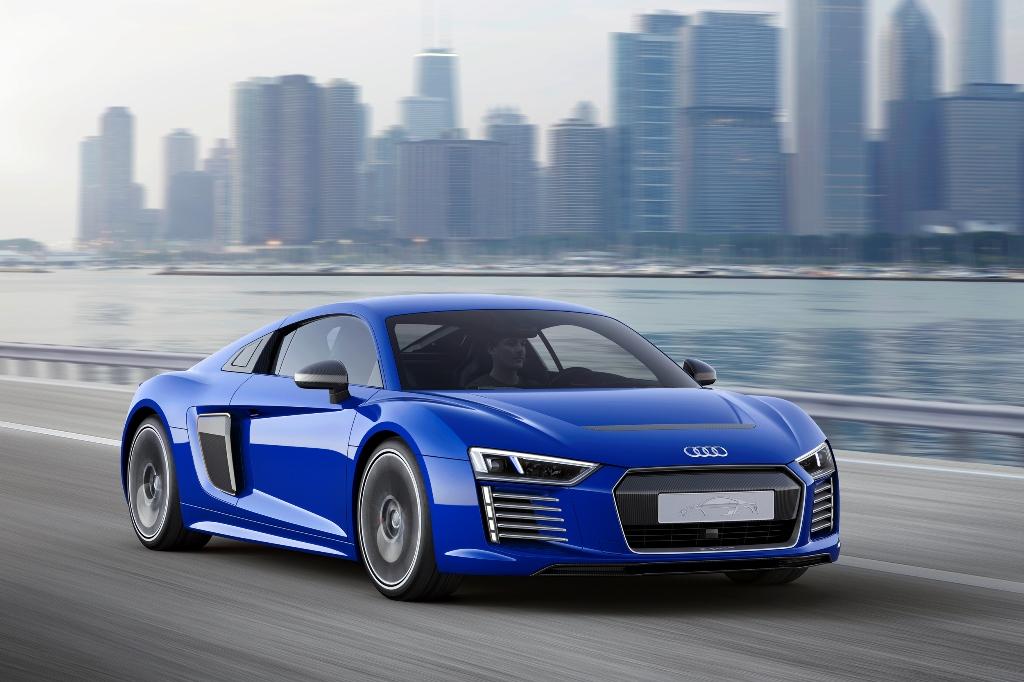340 kW of power, 0 to 100 km/h (62.1 mph) in 3.9 seconds and a driving range of 450 km (279.6 mi) – Audi has extensively developed its all-electrically powered high-performance R8 e-tron sports car further. The technology study is one of the highlights of CES Asia, and it brings together future technologies – which relate to lightweight design, high-performance drive systems and functions for piloted driving.
The Audi R8 e-tron piloted driving concept car is based on the multimaterial Space Frame of the new production R8. A rear car body module made of carbon fiber reinforced polymer (CFRP) integrates the luggage compartment, which extends the frame structure. The walls of the luggage compartment shell are corrugated, so that they can absorb extreme amounts of energy with little material weight in case of a rear-end collision. Thanks to specific modifications made to the outer shell and wheels, the Audi R8 e-tron piloted driving attains a low Cd value of 0.28. Its front end and sideblades feature e-tron specific lighting solutions.
The T-shaped battery is structurally integrated into the center tunnel and behind the occupant cell – its low center of gravity further boosts the already excellent driving dynamics of the R8 e-tron piloted driving. The high-voltage battery is based on a new lithium-ion technology that has, for the first time, been specifically designed for the drive system of an all-electric vehicle. Compared to the first technology platform, the battery’s energy capacity has grown from 49 kWh to approximately 92 kWh. Optimized space utilization and improved battery cell technology enabled this progress without requiring package modifications. Audi produces the high-voltage battery itself.
The R8 e-tron piloted driving achieves an electric range of 450 kilometers (279.6 mi) instead of a previous 215 kilometers (133.6 mi), its energy density was increased from 84 Wh/kg to 154 Wh/kg and several other modifications were made. The high-performance sports car has the Combined Charging System (CCS) on board, which allows charging with direct and alternating current. With this system, the customer can charge the large battery in significantly less than two hours.
The two electric motors each output 170 kW of power and 460 Nm (339.3 lb-ft) of torque to the rear axle. The R8 e-tron piloted driving rockets from 0 to 100 km/h (0 to 62.1 mph) in 3.9 seconds on its way to an electronically-governed top speed of 210 km/h (130.5 mph) or 250 km/h (155.3 mph), depending on the car’s tires. Intelligent energy management and an electromechanical brake system enable high energy recuperation rates. Targeted torque vectoring – needs-based distribution of power transmission between the rear wheels – ensures maximum stability and dynamism.
The R8 e-tron piloted driving technical study is equipped with all of the functions of piloted driving. Data is acquired from the interplay of an array of sensors: a new type of laser scanner, several video cameras, ultrasonic sensors and radar sensors at the front and rear. Based on signals from these sources, the central driver assistance control unit (zFAS), a compact central computer, computes a comprehensive picture of the vehicle’s environment.
Audi can build the R8 e-tron in handcrafted quality to meet special customer requests. The company uses its high-performance electric sports car primarily as a high-tech mobile laboratory.







